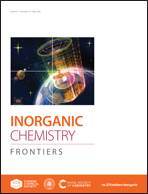The smallest endohedral borafullerene: structural isomerization, electronic properties, aromaticity and reactivity of U@C27B†
Abstract
Endohedral metalloazafullerenes (EMAFs)/metalloborafullerenes (EMBFs) are formed by encapsulating various metallic species inside the fullerene cages, of which some carbon atoms are replaced by nitrogen and boron, respectively. Currently, the characterization of their exact heteroatom positions on the cage mainly depends on the calculated relative energies at T = 0 K for isomers with varied heteroatom locations. In this work, density functional theory calculations were carried out to systematically investigate the structural characteristics, electronic properties, aromaticity and chemical reactivities of the recently synthesized U@C27B borafullerene. Interestingly, besides the reported major U@Td-C27B-[5,5,6] isomer, calculations considering the entropy effect at cage formation temperatures suggest that it may have another major U@Td-C27B-[5,5,6] isomer and a minor U@Td-C27B-[5,5,5] isomer with changed boron positions. The reported U@Td-C27B-[5,5,6] and new U@Td-C27B-[5,5,5] isomers could interconvert via a single bond rotation at elevated temperatures with energy barriers comparable to that of the classical Stone–Wales rearrangement in fullerene transformation. The internal U atom formally assumes the highest VI oxidation state regardless of the cage topology or B location. Unprecedentedly, metal–cage bonding also shows strong covalency with the U atom and the C27B cage of U@Td-C27B sharing the same 32 valence electrons to obey the 32-electron principle and Hirsch's 2(N + 1)2 rule (N = 3 with a 1S21P61D101F14 electronic configuration) for spherical aromaticity, respectively. Such a novel mutual stabilization mechanism is similar to that of the classical organometallic compound, ferrocene. The neutral U@Td-C27B isomers are radicals with one unpaired electron on the cage and thus may spontaneously form dimers with closed-shell structures. We propose that one could obtain the U@Td-C27B monomer via radical addition reactions such as trifluoromethylation. Our work demonstrates the intriguing structures and properties as well as their correlations of the emerging EMBFs. The possible coexistence of multiple isomers and their interconversion are unprecedented and could also guide more in-depth studies on EMAFs as well as other types of heterofullerenes.



 Please wait while we load your content...
Please wait while we load your content...